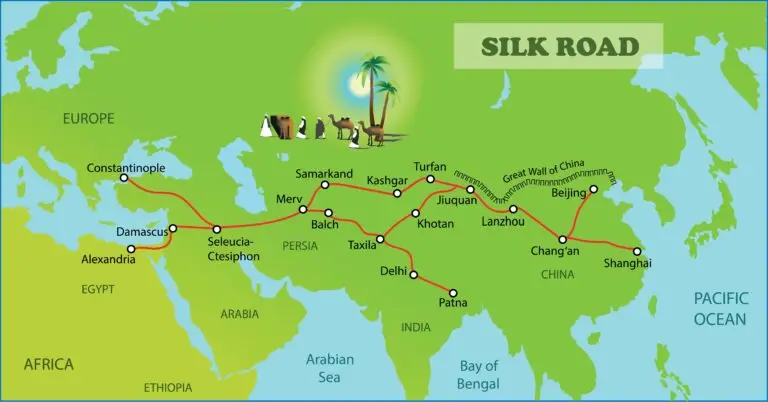Silk Road

Table of Contents
What was the Silk Road?
The Silk Road was a network of ancient trade routes that connected the East and West, facilitating the exchange of goods, ideas, cultures, and technologies between civilizations in Asia, Europe, and Africa.
The Silk Road was not a single route but rather a complex network of overland and maritime routes that stretched across Eurasia, linking regions such as China, India, Persia, Central Asia, and the Mediterranean. This network was named for the lucrative trade in silk, which was highly prized in the West and was a major commodity traded along the routes.
However, the Silk Road also facilitated the exchange of many other goods, including spices, precious metals, textiles, ceramics, and exotic animals. In addition to trade, the Silk Road played a crucial role in the diffusion of religions, philosophies, technologies, and cultural practices, contributing to the development of diverse societies and civilizations along its routes. The Silk Road reached its peak during the Han Dynasty in China and the Roman Empire, but continued to be important until the end of the Middle Ages.
Silk Road History
The Silk Road was an ancient network of trade routes that connected the East and West, facilitating the exchange of goods, ideas, cultures, and technologies between civilizations.
This connection spanned thousands of miles across Asia, linking China in the East to the Mediterranean world in the West, and passing through regions such as Central Asia, the Indian subcontinent, the Middle East, and Europe.
The name “Silk Road” originates from the lucrative trade in silk, a highly prized commodity produced in China, which became one of the most sought-after goods exchanged along the route.
The Silk Road was not a single road but rather a complex network of overland and maritime routes, including caravan trails, desert tracks, mountain passes, and sea routes across the Indian Ocean.
Alongside silk, other goods traded along the Silk Road included spices, precious metals and gems, textiles, ceramics, tea, paper, and technologies such as gunpowder and compasses.
The Silk Road facilitated cultural exchange and interaction between diverse civilizations, leading to the spread of religions such as Buddhism, Christianity, Islam, and Zoroastrianism, as well as the transmission of languages, arts, and sciences.
It also played a crucial role in the diffusion of knowledge and ideas, fostering intellectual exchange and the transfer of innovations such as mathematics, astronomy, medicine, and literature.
The Silk Road also facilitated the movement of people, including merchants, diplomats, scholars, missionaries, and travelers, who traversed vast distances and encountered different cultures and societies along the way.
The decline of the Silk Road began with the rise of maritime trade routes in the Indian Ocean and the Mediterranean, as well as geopolitical changes such as the Mongol conquests and the decline of the Silk Road cities.
Despite its eventual decline, the Silk Road remains a symbol of globalization, interconnectedness, and cultural diversity, and its legacy continues to influence contemporary trade, diplomacy, and cultural exchange in Eurasia and beyond.It
Related Links
Age of Exploration
Globalization
Mongol Empire
Suez Canal